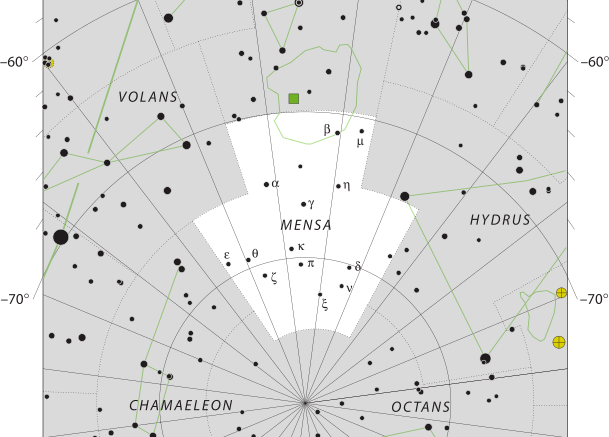Mensa is a constellation in the Southern Celestial Hemisphere near the south celestial pole. Mensa is 1 of 12 constellations created in the 18th century by French astronomer Nicolas-Louis de Lacaille. Its name is Latin for table, though it originally commemorated Table Mountain and was known as Mons Mensae. One of the eighty-eight constellations designated by the International Astronomical Union (IAU), it covers a keystone-shaped wedge of sky 153.5 square degrees in area. Other than the south polar constellation of Octans, it is the most southerly of constellations and is observable only south of the 5th parallel of the Northern Hemisphere.
Mensa is one of the faintest constellations in the night sky, and it contains no apparently bright stars. The brightest star in the constellation Alpha Mensae is barely visible in suburban skies. Part of the Large Magellanic Cloud, several star clusters, and a quasar lie in the area covered by the constellation, and at least three of its star systems have been found to have exoplanets.
| Applicable Information | |
| Visibility In Pacific Northwest | Never visible in PNW |
| Best Times To View | Never visible |
| Right Ascension | 03h 12m 55.9008s – 07h 36m 51.5289s |
| Declination | −71° – −85.5° |
| Area | 153 square degrees |
| Main Stars | 4 |
| Brightest Object | α Men |
| Meteor showers | 0 |
| Messier objects | 0 |
| Neighboring Constellations | Chamaeleon, Dorado, Hydrus, Octans, Volans |
Mythology
Although the stars of Mensa do not feature in any ancient mythology, the mountain it is named after has a rich mythology. In Dutch and German, the constellation is called “Tafelberg”, with 2 neighboring mountains called “Devil’s Peak” and “Lion’s Head”. Table Mountain features in the mythology of the Cape of Good Hope, notorious for its storms. Explorer Bartolomeu Dias saw the mountain as a mythical anvil for storms.
Stars
Lacaille gave eleven stars in the constellation Bayer designations, using the Greek alphabet to label them Alpha through to Lambda Mensae. Alpha Mensae is the brightest star with a barely visible apparent magnitude of 5.09, making it the only constellation with no star above magnitude 5.0. Overall, there are 22 stars within the constellation’s borders brighter than or equal to apparent magnitude 6.5.
The Large Magellanic Cloud lies partially within Mensa’s boundaries, although most of it lies in the neighboring constellation of Dorado. Mensa is a satellite galaxy of the Milky Way, located at a distance of 163,000 light-years.
Among its stars within Mensa are an unusual yellow-white supergiant, a blue hypergiant, a luminous blue variable star, and NGC 1987, a globular cluster. In NGC 1987, there are a significant number of red aging stars, and there is NGC 1848, a 27 million year old open cluster. Mensa contains several described open clusters, most of which can be only be clearly observed from large telescopes.
Make sure to check out other articles on the site, including a brief introduction to constellations, other constellation articles, and more!

Be the first to comment on "Mensa"